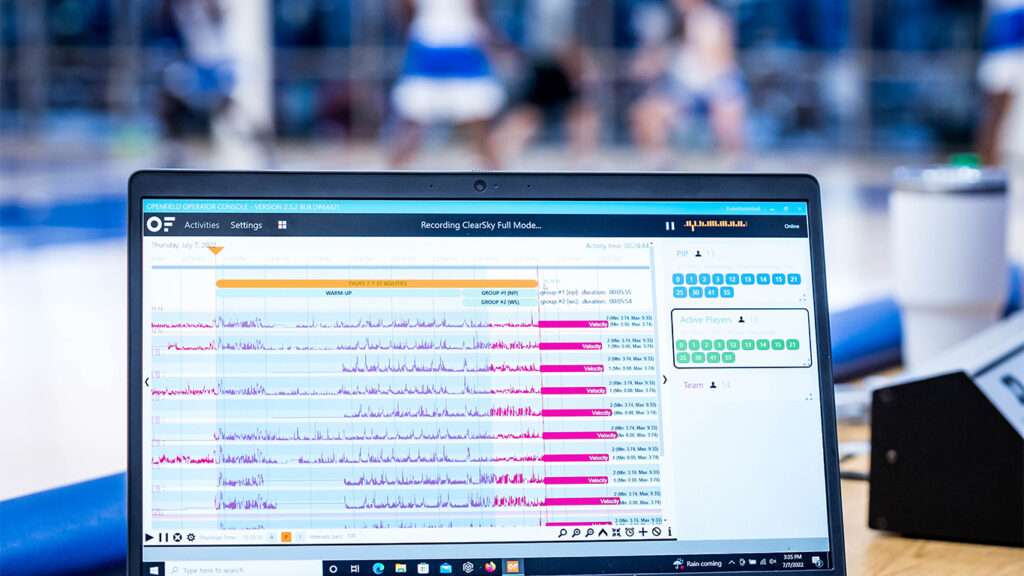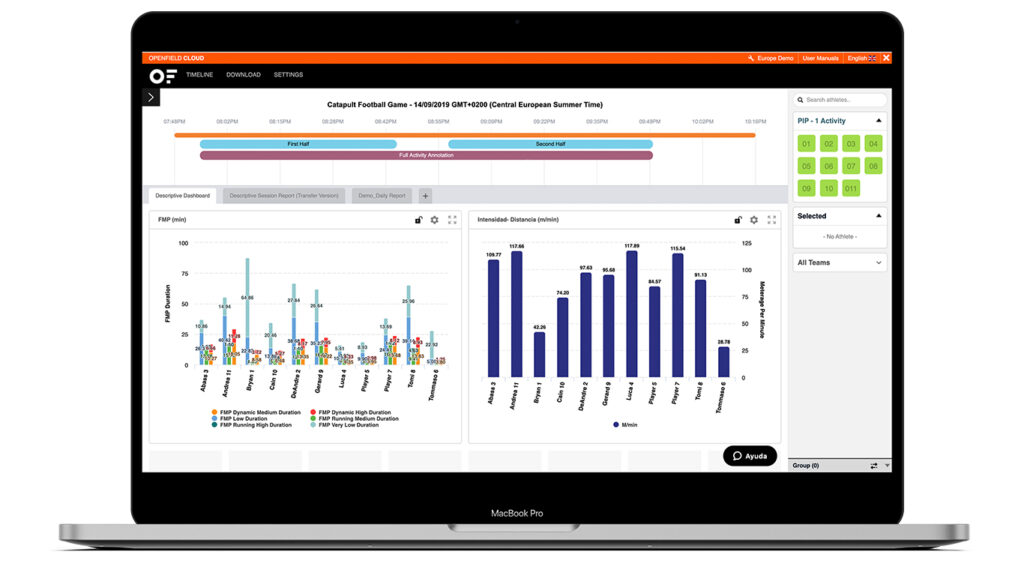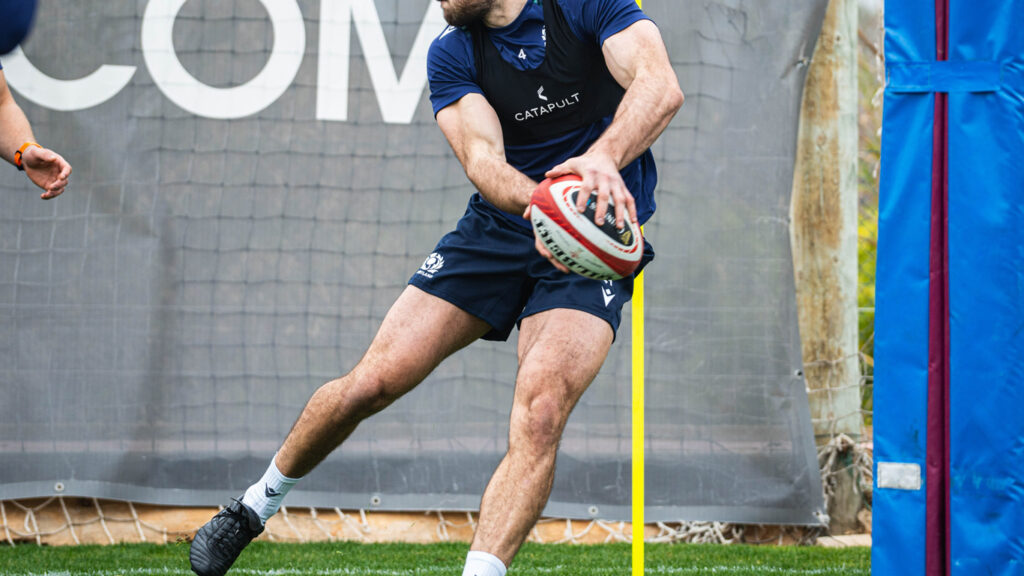Sports Analytics: What is it & How it Improves Performance?
Sports analytics is about using data to help athletes and teams perform better. It’s a new approach that takes the guesswork out of coaching, giving clear insights that help improve training and tactics.
This method is changing various sports by making it easier to understand what makes an athlete or team successful. Sports analytics blog, contents list:
- Sports Analytics Foundations
- What is Sports Analytics?
- Application of Sports Analytics
- Performance Metrics and KPIs
- Injury Prevention and Analytics
- Success Stories
- Conclusion

1. Sports Analytics Foundations
At its core, sports analytics embodies the blend of data science and athletic performance, providing a blueprint that guides decision-making processes, from strategising game plans to refining individual skills. Its significance in today’s sports ecosystem cannot be overstated.
As competitions grow increasingly fierce, the margin for error narrows, making the nuanced advantages uncovered through data analytics in sports not just desirable but essential. This foundational aspect of sports analytics paves the way for a new era in sports, where informed decisions lead to unparalleled achievements on the field.
Transcending Traditional Boundaries
Sports analytics transcends mere statistics, offering a granular view of performance that encompasses a wide array of factors, including physical fitness, tactical acumen, and even psychological readiness. The essence of what sports analytics entails is the transformation of raw data into actionable insights that elevate the performance bar, ensuring athletes and teams not only keep pace with their rivals but also outstrip them.
By transcending traditional coaching and training methodologies, sports analytics opens up new vistas for performance enhancement, heralding a future where data-driven strategies become the cornerstone of sporting excellence.
As we delve deeper into the applications and impacts of sports analytics, it becomes clear that this is not just a fleeting trend but a fundamental shift in how sports performance is approached and enhanced. Through its meticulous methodologies, sports analytics lights the path to victory, providing a lens through which the future of sports is not only envisioned but meticulously crafted.

2. What is Sports Analytics?
Sports analytics is the art and science of applying data analysis techniques to the sports industry, aimed at improving player performance and achieving competitive advantage. It involves the systematic computational analysis of sports-related data.
At its simplest, sports analytics translates the vast and complex datasets generated in sports contexts into meaningful insights that can drive decision-making and performance improvements.
The inception of sports analytics can be traced back to the late 20th century, though it gained significant prominence in the early 21st century with the advent of advanced technologies and the digital revolution. Initially, its adoption was slow, and viewed with skepticism by traditionalists in the sporting world.
However, the undeniable success stories of teams and individuals who embraced data analytics paved the way for widespread acceptance. Today, it is considered an indispensable part of modern sports, from grassroots campaigns to the pinnacle of professional leagues.

Decoding the Numbers
At the heart of sports analytics is the process of decoding the numbers – transforming raw data into actionable insights. This process encompasses the collection, analysis, and interpretation of data, which can range from player biometrics to team performance statistics. The ultimate goal is to optimize performance, whether by enhancing an athlete’s physical condition, refining tactical approaches, or preventing injuries (mitigating injuries – more on that soon).
This journey begins with the meticulous collection of data through various means such as wearable technology, video analysis, and performance tracking systems. The analysis then dives deep into this data, employing statistical models, machine learning algorithms, and predictive analytics to uncover patterns and trends that may not be immediately apparent. Finally, the interpretation of this data translates complex metrics into straightforward, actionable strategies that coaches, players, and other stakeholders can leverage.
Sports analytics thus serves as a bridge between the raw potential of data and the tangible improvement of sports performance. Decoding the numbers, provides a clearer picture of where improvements can be made, how strategies can be adjusted, and what measures can be taken to ensure athletes are performing at their optimal level.

3. Applications of Sports Analytics Across Different Sports
Catapult excels in working with multiple sports industries to optimise performance by leveraging cutting-edge sports analytics technology.
This global leader in sports performance analytics provides comprehensive solutions that enhance the performance and strategic planning of teams and athletes across a diverse array of sports. By implementing sophisticated data collection methods and analysis tools, Catapult transforms how teams approach training, game strategy, and player development.
Football/Soccer
In football/soccer, Catapult’s analytics tools are designed to capture and interpret player movements, actions on the field, and physical exertions to inform coaching strategies and player development. Metrics such as player workload, movement efficiency, and game-specific physical profiles help teams optimise training, reduce injury risks, and improve player performance.
Basketball
Basketball teams utilise Catapult’s analytics for insights into player endurance, peak performance periods, and on-court actions that influence game outcomes. Through detailed movement profiles, teams can tailor training and strategies to enhance player efficiency, decision-making, and overall team dynamics.

Baseball
Catapult’s analytics services for baseball cover everything from pitching mechanics and batting performance to fielding dynamics. Data-driven insights assist in refining techniques, improving player conditioning, and strategising game plays, contributing to enhanced individual and team performances.

Cricket
In cricket, analytics tools provided by Catapult focus on aspects such as bowling speeds, batting techniques, and fielding movements. These insights allow for personalised training programs and tactical decisions that align with individual player strengths and team objectives.
Ice Hockey
For ice hockey, Catapult’s technology captures high-intensity movements, player collisions, and on-ice strategies. Analytical data is used to improve player safety, conditioning, and game tactics, ensuring teams maintain a competitive edge.

Motorsport – F1
In the high-speed world of motorsport, especially Formula 1, Catapult’s analytics contribute to vehicle performance, race strategy, and driver conditioning. Through precise data analysis, teams can make informed decisions on car setup, pit stop strategy, and driver performance optimization.
Rugby
Rugby benefits from sports analytics through detailed analysis of player movements, impacts, and play strategies. Catapult’s tools help in managing player workloads, improving tactical decisions, and enhancing overall team performance through data-driven insights.

These applications across various sports highlight the versatility and impact of sports analytics in enhancing performance, reducing injury risks, and shaping the future of sports. Catapult’s role in this revolution demonstrates the power of data in transforming athletic performance at all levels.
4. Performance Metrics and Key Indicators
With sports analytics, the application of performance metrics and key indicators is fundamental to unlocking the full potential of athletes and teams. This critical aspect of sports science transforms raw data into a strategic asset, enabling a deeper understanding of performance dynamics across various sports disciplines.
Metrics that Matter
The cornerstone of sports analytics lies in identifying and analysing the ‘Metrics that Matter’ – crucial performance indicators that provide insights into an athlete’s efficiency, effectiveness, and overall contribution to the team’s objectives. These metrics, tailored to the specific demands and nuances of each sport and position, form the backbone of data-driven decision-making in sports.
In team sports like football/soccer and basketball, common metrics include distance covered, sprints, accelerations, decelerations, and workload intensity. These indicators help in assessing an athlete’s stamina, speed, and in-game dynamics. Position-specific metrics, such as passes completed for midfielders or shot accuracy for forwards, offer deeper insights into player roles and effectiveness.

For individual sports, such as athletics or swimming, metrics might focus on time, biomechanical efficiency, and technical precision. In cricket, bowling speed, batting averages, and fielding efficiency are critical, while in rugby, tackle success rates, ruck contributions, and metres gained are pivotal.
Differences in sports also necessitate unique metrics; for motorsport, data points like lap times, tyre degradation, and fuel efficiency are vital. In contrast, ice hockey analytics may focus on puck possession, shot-blocking, and goalie save percentages.
Catapult’s nomination for best tech for data and analytics at the 2023 Sports Technology Awards underscores their leading-edge capabilities in this field. Their technologies exemplify how advanced metrics and analytics can significantly enhance sports performance and strategy formulation. Through innovative tools and analytics platforms, Catapult provides coaches, athletes, and sports scientists with actionable insights, optimising training, game strategy, and player development.
The video, above, showcasing this technology offers a glimpse into the sophisticated analytics tools and methodologies employed by Catapult, highlighting their impact on sports performance across the globe. This recognition not only reflects Catapult’s contributions to sports analytics but also emphasizes the growing importance of data in sculpting the future of sports performance.
Through meticulous analysis and interpretation, performance metrics and key indicators illuminate the path to excellence, enabling athletes and teams to not only achieve but exceed their performance goals.
5. Injury Prevention and Sports Analytics
Injury prevention stands as a paramount concern in the competitive sports arena, where the fine line between peak performance and overexertion often leads to physical setbacks.
While no data or technology can truly prevent injuries, sports analytics plays a critical role in mitigating the risks associated with athletic pursuits. By harnessing the power of data, coaches and medical teams are better equipped to implement strategies that safeguard athletes’ well-being without compromising their performance.

The Role of Data in Mitigating Injury Risks
The essence of sports analytics in injury prevention lies in its ability to identify patterns, stressors, and risk factors inherent in athletes’ training and competitive engagements.
Through detailed analysis of workload, movement mechanics, and physiological responses, sports analytics provides a proactive framework for managing athletes’ health. This strategic application of data helps in tailoring recovery protocols, adjusting training intensities, and ultimately reducing the occurrence of injuries.
Catapult’s Contribution to Injury Prevention
Catapult’s innovative approach to integrating sports analytics into injury prevention strategies is illustrative of the field’s potential. This work, particularly in the context of baseball, offers insights into how data can be leveraged to address the injury epidemic plaguing the sport. The blog titled “HOW CATAPULT IS HELPING PROFESSIONAL BASEBALL TACKLE THE $423M INJURY EPIDEMIC” highlights the use of Catapult’s analytics to monitor player workload, optimise training schedules, and identify early signs of potential injury risks.
By analysing metrics such as player velocity, acceleration patterns, and exertion levels, Catapult’s technologies enable teams to customise training regimes that align with each athlete’s physical capabilities and recovery needs. This personalised approach to training not only enhances performance but significantly reduces the likelihood of injuries.

Protecting Athlete Performance
The strategic use of data to protect athlete performance goes beyond the identification of injury patterns; it encompasses the holistic management of workload and the enhancement of athlete recovery processes. Through the meticulous analysis of performance data, sports analytics tools enable the early detection of potential overuse injuries, allowing for timely intervention. This approach aids in balancing training intensity with adequate recovery time, ensuring athletes maintain optimal health and performance levels.
The ability to quantify and analyse workload and recovery metrics provides a clear framework for developing individualised training and recovery plans. This ensures that athletes are not only performing at their peak but are also protected from the risks of overtraining and injury. By prioritising athlete health through data-driven insights, sports organisations can foster a culture of sustainable performance and long-term athlete development.
While technology cannot eliminate the inherent risks of sports, the application of sports analytics in injury prevention represents a significant advancement in managing these challenges. It epitomizes the synergy between data science and sports medicine, opening new avenues for enhancing athlete care and performance sustainability.

6. Sports Analytics Success Stories
Football/Soccer
– Sweden Women’s National Team: Leveraged Catapult’s sports analytics to enhance team performance and strategy, leading to significant improvements in player fitness and tactical execution on the field.
Basketball
– UNLV Lady Rebels: Implemented video analysis and movement profiling from Catapult to optimise player performance, resulting in improved game strategy and player development.
– Basketball Movement Profile: Provided teams with detailed insights into player movements, aiding in the customisation of training regimes and injury prevention strategies.
Baseball
– Vanderbilt Baseball: Utilised Catapult’s analytics to enhance athlete performance through detailed tracking of player movements and workload management, contributing to both individual player development and team success.

Cricket
– Cricket Algorithm: Catapult’s advanced analytics offered cricket teams and coaches new perspectives on player performance, enabling targeted improvements in technique and strategy.
Ice Hockey
– LA Kings: The team adopted Catapult’s goalie metrics and a 360-view analysis for every player, enriching player assessment and fostering a data-driven approach to performance enhancement and tactical planning.

Motorsport – F1
– Race Strategy Analysis: Catapult’s in-depth analysis tools provided Formula 1 teams with critical insights into race strategies, vehicle performance, and driver efficiency, driving improvements in both strategy formulation and execution.
Rugby
– Italy Rugby Six Nations: By integrating Catapult’s sports analytics, the Italy Rugby team gained actionable insights into player performance, helping to refine training methods and match strategies, which were pivotal in their Six Nations campaign.

These encapsulated stories demonstrate Catapult’s broad impact across different sports, showcasing how their analytics platforms have been instrumental in advancing athlete performance, enhancing team strategies, and contributing to notable successes in competitive sports arenas.
7. Sports Analytics Conclusion
Sports analytics has changed the game. It’s taken a massive amount of data from different sports and turned it into useful advice that helps athletes and teams get better. From improving how players train and play to keeping them safe from injuries, the role of data in sports is huge.
Looking at successes in football, basketball, cricket, and more, it’s clear that using data works. Companies like Catapult are at the forefront, showing how knowing the numbers can lead to winning strategies and better performances. Whether it’s helping a team plan their tactics or a player up their game, sports analytics is the key.
And this is just the beginning. As technology gets better, so will the insights from sports analytics. This means we can expect even smarter strategies, finer skills, and safer sports environments in the future.
In simple terms, sports analytics isn’t just about dealing with data. It’s about making dreams come true, unlocking potential, and taking sports to the next level. As we move forward, the impact of analytics will only grow, making it an exciting time for the world of sports.